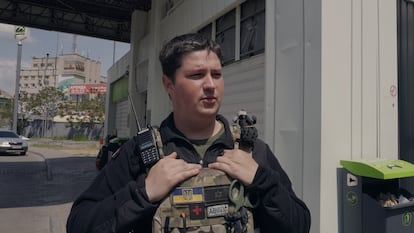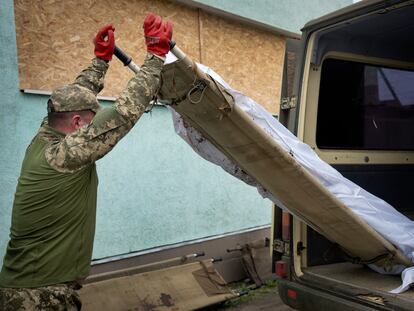Mission: capture Russian collaborators in Ukraine
Authorities in Kherson and other cities liberated by Ukrainian troops now face the problem of detecting informers loyal to Moscow
The dog, an old mastiff, is named Larchi after her former owner. Larchi, who still lives in the house of her previous master, the former mayor of Snihurivka, Oleksander Larchenko, barks incessantly at her visitors. But the Larchenko family no longer occupies the residence, which is under the watch of a guard and soldiers who appear from time to time. They have renamed the dog. The alderman fled last November, when an advance unit of Ukrainian special forces took control of the municipality. He was the visible head of an administration that had collaborated with the Russian occupiers.
Snihurivka is a small town in southern Ukraine, on the banks of the Inhulets River. It is situated in a border region between three provinces, Mykolaiv, Dnipropetrovsk, and Kherson. Crossing this tributary of the Dnipro and expelling Russian troops from the western side of the river had been a strategic objective of the Ukrainian Armed Forces for months. In November, the counteroffensive forced a Russian withdrawal from the right bank of the Dnipro and a new phase began in the region, that of seeking out Russian collaborators and spies. Snihurivka, like the city of Kherson itself, was captured by the Russians with practically no resistance, with the support of sections of the political class and even the local military establishment.
A resident of Snihurivka, an elderly woman, had attracted the attention of the Ukrainian authorities because, although she theoretically lived alone, every day she collected enough humanitarian aid to feed a large family. When the intelligence services began to follow her, they discovered that she was also buying men’s clothing. In the second week of May, the special forces battalion commanded by Vladislav (an assumed name) raided the basement of the woman’s house and found Russian soldiers hiding there. That day they arrested 30 Russians hiding out in various locations. Vladislav does not want to specify whether they were all soldiers who had been left behind during the retreat or whether some were spetznatz, Russian special forces infiltrated from the other side of the front to gather information or carry out sabotage operations.
Vladislav speaks to EL PAÍS at the roadside, in front of the Inhulets restaurant. There are few people left in the town and the cars that pass by honk their horns at the battalion commander as a sign of respect. He is the authority now in Snihurivka. The restaurant was bombed, but on the locked entrance door there is graffiti left by a local drug dealer offering amphetamines, cocaine, and marijuana. During the eight months of Russian occupation, Inhulets was used by the invading army as a torture chamber. “People in the neighborhood would hear screams coming out of the restaurant,” says Luba Zhigalko, an elementary school teacher who left the village on April 1, 2022, to go live with her son in Zaragoza, Spain. She returned last March when she learned that her husband had died, of natural causes. “The town is empty, it’s very sad,” she says.
Pro-Kremlin collaborators continue to be a problem, Vladislav acknowledges. He recalls that on one occasion, he and his men were hiding on the outskirts of a village they had infiltrated on a secret mission, behind Russian lines. A villager approached them to greet them, confirming that they were Ukrainians. They watched as he threw his cell phone away a few meters away from them. They immediately understood the device was pinpointing their location and made a hasty retreat. Within minutes, the position was shelled. Vladislav even claims that military commanders in Snihurivka provided armored vehicles to the invading Russian troops.
“Everyone in Snihurivka knows where our base is,” says one of Vladislav’s men. “Someone could pass the coordinates to the Russians, sure, but they don’t because we have the town under control and we would catch them in a matter of hours.”
Collaborationism is a problem that senior military and political officials in eastern Ukraine, the half of the country historically closest aligned to Russian culture, have acknowledged to this newspaper. In July 2022, Pavlo Kirilenko, the governor of Donetsk, confirmed in a meeting with journalists that Russian informants are a major concern. Kirilenko provided the math: if 20% of the pre-war population remained in the province, half of them would be pro-Russian.
A tip-off is the only explanation for an Iskander missile attack on a nondescript building in an industrial park on the outskirts of the city of Zaporizhzhia on May 5, according to an army officer consulted by this newspaper. EL PAÍS correspondents witnessed the attack and went to the site of the target, where soldiers were billeted.
Volodymyr Kredovskii says that many people left Snihurivka when the Russian troops withdrew. How many, he cannot say, but he is proud to have been among those who played their part by passing information to the Ukrainian Army about enemy positions inside the village. He was the owner of a garage that was destroyed in the fighting and the town council has compensated him by hiring him to guard the remains of a pedestrian bridge blown up during the Russian retreat. In times of economic crisis, the twisted ironwork that remains is a treasure for scrap metal dealers.
Kredovskii is 63 and spends his time fishing in the Inhulets. He fills a bucket with the small carp he catches while chain smoking cigarettes. In his opinion, Kyiv’s greatest military mistake was not to have blown up the Antonovsky Bridge, the main road across the Dnipro as it passes through Kherson. The seizure of the province in a matter of days at the beginning of the invasion was partly due to the fact that Ukrainian defenses were weaker in the south than in the north and east, but also because the Russians were aided by support of local administrations and the passive attitude of military commanders in the region.
EL PAÍS gained access to the city of Kherson a few days after it was liberated. Civilians were prevented from leaving because the security services were tracking those residents who had collaborated with the enemy. Arrests were made. A three-day curfew was imposed in early May. Oleksandr Prokudin, head of the provincial military administration, announced that the measure was necessary to identify collaborators who were providing information on the movement of Ukrainian troops.
“Tell me, who is lying more, the Ukrainians or the Russians?” Elena asks journalists during a walk along Ushakovka Avenue, Kherson’s main thoroughfare. She is convinced that there are shells falling n the city that are not Russian but are being fired by Ukrainian artillery, perhaps by mistake, perhaps not. She has her doubts. Elena, 47, is aggrieved that the police stop her on the street to check her cell phone, in case she has any connection with the Russians. Oleksandr Lutsenko is a 29-year-old greengrocer at a local market in Kherson. He corroborates Elena’s story: during the Russian occupation, security checks were constant. Most of the city’s residents chose not to go out on the streets, according to testimonies collected by this newspaper last November. There were multiple raids to arrest hundreds of men suspected of being loyal to Ukraine, who would then disappear.
Elena explains that people continue to remain indoors after the liberation. The city is shelled on a daily basis and when missiles strike near her apartment block, she hides the cat in the washing machine, she says. Elena also suspects that Ukrainian anti-aircraft defenses are not operational in Kherson.

As evening falls, Ushakovka Avenue becomes even more devoid of passersby. The few vehicles on the road are mostly military, and they are moving fast. The front is right here, in a straight line. The avenue ends at the river promenade that runs along the Dnipro: 500 meters away, on the far bank, is the Russian Army. No signs warning of the danger are necessary. There is not a soul on the promenade, only the remains of a bus destroyed by enemy fire. From that point on, every step toward the water is a step toward death.
About this project
A multimedia team of four journalists from EL PAÍS traveled across eastern Ukraine, covering 1,200 kilometers between Kharkiv and Kherson, in the weeks prior to the counter-offensive that will determine how far can the country go in its quest to liberate the territory conquered by Russia.
Dozens of testimonies from civilians and soldiers collected along the front line portray the impact that a long-lasting war is having on the day-to-day life of the population: drinking beer in a bar while receiving a Telegram notice that a missile will fall on you shortly; life in a line of towns that have become part of the battle front; what it is like to celebrate your golden anniversary in the middle of a devastated city; the daily life of the soldiers, which also consists of many moments of waiting; the fear of living across from the largest nuclear power plant in Europe, now occupied by Russia, in the middle of a conflict; being a teenager and living 12 kilometers from the dangerous Bakhmut front, confined at home and receiving online classes; and finally Kiyv's search for Russian collaborators.
It is a series of seven reports about how life goes on despite everything, in the middle of the violence and destruction of war, at a decisive moment for Ukraine: a counter-offensive where its destiny is at stake.
Credits
Follow all the international news on Facebook and Twitter, or on our weekly newsletter.

